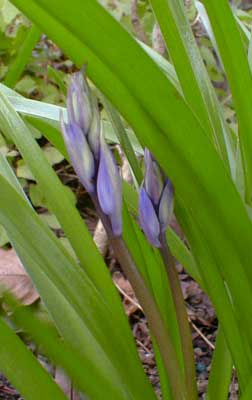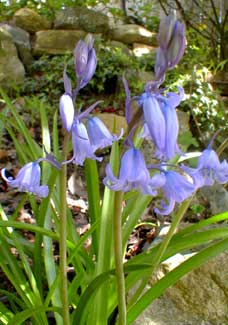
English Bluebells,
Wood Hyacinth,
Endymion, or
Nodding Squill:
Its Folk-names,
Folklore, History & Care
"Are you ready?" the Snowdrop asked,
"'Tis time to start, you know."
"Almost, my dear!" the Scilla replied,
"I'll follow as soon as you go."
"Flower Chorus"
by Ralph Waldo Emerson
Hyacinthoides non-scripta, the English bluebells or blue squill, is synonymous with Scilla non-scripta & formerly called Endymion non-scriptus, Scilla campanulata, & Scilla nutans. It was also once known as Agraphis nutans.by Ralph Waldo Emerson
"Nutans" means "nodding," alluding to the dangling flowers, hence the common name Nodding Squill. "Agraphis" means "unmarked" or "not written on," which is essentially the same as the modern species name non-scripta alluding to the clarity of its blue color, & alluding to a specific Greek myth.
 In Greek myth, the hyacinth was said to have markings on it similar to the Greek "AI AI" which means "Alas!" These markings were written there by Apollo himself as a lament, & to comemorate the grief of the gods over the death of Hyacinthos, the shared catamite of Zeus, Zephyr, & Apollo.
In Greek myth, the hyacinth was said to have markings on it similar to the Greek "AI AI" which means "Alas!" These markings were written there by Apollo himself as a lament, & to comemorate the grief of the gods over the death of Hyacinthos, the shared catamite of Zeus, Zephyr, & Apollo.The name "non-scriptus" distinguishes scilla as lacking the writing of Apollo, as distinct from the marked species (the myth probably alluded to the wild Hyacinthus orientalis albulus from which huge hybrid hyacinths are descended).
English Squill is shown at page-top in an in March bud & in the second photo in April bloom. The Spanish bluebells are naturalized in many places around the gardens, but only one area has the true English bluebell, which seems always to be smaller grassy clumps than the Spanish, & easy to distinguish because the bells all hang together on one side of the flower stems for the English only. Six or eight inches of squill-grass erupts January & February, & it blooms extravagantly in early April.
Although it is best known today as English Bluebells, it is sometimes called Harebells though that is a name I'd apply only to a campanula, the Scottish Harebell, which are in turn sometimes called Bluebells of Scotland. So when a Scot versus a Brit or Welshman spreak of "Bluebells" they may be speaking of entirely different plants.
Other common names, only a few of which are still in regional use, include Wood Bells, Wood Hyacinth, Wild Hyacinth or Wild Jacinth, Bats-in-the-belfry, Chimney Bellflowers, Coventry Bells, Canterbury Bells, Pentecostal Bells, Ring-o-Bells, Our Lady's Nightcaps, Our Lady's Thimbles, Witches' Thimbles, Throatwort, Venus's Looking Glass, Locks-and-Keys, English Rampion, Mariets, Viola Mariana, Mercury's Violet, Goosie Gander, Sapphire Queen, Snap Grass, Wild Williams, just for starters.
The name Crawfeet, Crawtoes, or Crawtraes means "Crow's Feet" or "Crow's Toes," & the folk-name Cuckoo's Boots would seem likewise to assume some resemblance to birds' claws. They would make good Cuckoo's Boots because they are in bloom at the same time as the Cuckoos began calling for their mates.
Another bird-reference is the long obsolete name Calverkeys or Culverkeys which means "Dove's Key" but possibly "a Dove's musical note." It is also an English place-name, but not improbably alludes to the Dove because doves were sacred to Aphrodite, also associated in ancient Judaism with Temple offerings, & among early christians with the Virgin Mary & with Sophia as the Holy Spirit, the "mother" among the Trinity.
Blue Granfer, Blue Grammer, Grammar Griggles, Gramfer Griggles, Grammar Griggles, are primarily Dorset names for either English Bluebells or a purple terrestrial orchid that blooms alongside it at the same time of year. These names could be rendered Blue Granny, or Grandmother Griggles, which can be taken to mean Granny Apples. But a Griggle is not just any apple. It's a small hard scabrous apple left behind on the tree, because nobody wants to eat such a nasty thing.
The root word grig indicates a thing smaller than intended, & is a dialect word for a singing cricket or a small lively person. Griggles additionally can be vulgar, as for a bull's griggles, or a boar's griggles, their testes being smaller than expected. These names allude in the main to the bulbs of the terrestrial orchids & squills, which are inedible, & for squill in particular, quite poisonous.
Nor would it surpise me if Granny Griggles was once a local witch or hag-fairy, so that another folkname is Witches' Thimbles. Even the implied vulgarity may have reflected negatively on sexual excess or deviation, since squills were once sacred to Aphrodite.
They were called Adder's Flowers from a belief that a gluey extract of the bulbs could cure snakebite. Scilla has no starch in the bulbs, but it does have a great deal of muselage & insulin that functions as a glue or laundry starch. Traditionally it was used to stiffen the fancy ruff collars of Elizabethans, as the glue for fletching arrows, & as a bookbinder's glue that due to its toxicity repelled silverfish.
Squill is mentioned as a medicinal plant by Theophrastus in 300 B.C.E. & it was used by the Greek physician Epimenides, for which reason squill has also been known as Epimenidea. It is toxic, & traditionally used (carefully, one hopes) as an expecterant assisting lung ailments & as a diuretic curing dropsy & ailments of the kidneys.
It has occasionally been mixed with digitalis as a heart medicine. But if you were feeling poorly & gobbled down a bulb to see if that helped, expect to become violently ill, fall into a stupor or into convulsions, with temperature loss, & soonafter find out whether or not there is an afterlife. Its other traditional use was as a rat poison.
The toxicity may be the origin of the superstitious belief that it was used in witches' potions, or that anyone who wanders into a ring of bluebells will fall under fairy enchantment & soon after die. Bluebells were long regarded as the flower of grief, due to their association with devilish fairies, as well as the grief of Apollo over the death of Hyacinthos.
Not all its folklore is so gloomy. Some believed that by wearing a wreath made of the flowers, they would be compelled to speak only truth. Others believed that if you could turn one of the flowers inside out without tearing it, you would eventually win the one you love.
This association with Love derives from the flower's association with Aphrodite, & is why one of its folk-names is Venus's Looking Glass, & even some of the folk-names now assumed to allude to the Virgin Mary (such as Our Lady's Thimbels or Our Lady's Nightcaps) may have coopted the association with a vastly more ancient fertility goddess than Mary, who was herself often associated with the color blue.
The very name Scilla was that of an Aphrodite-like Sea-goddess of the Etruscans, although the Greeks villified this ancient Mother Goddess as the sea-monster Scylla who preyed upon sailors.
Also in the gardens longer than we've owned the house are White English Squill which have naturalized separately in numerous places. The blues, but curiously not the whites, have naturalized with a great deal of grape hyacinth, as it appears that blue squills best like a bit more sun, while the white reliably hides in the darkest places.
Some gardeners might find it alarming how far these can spread. The previous owners of our house just let them go wild. I've not found them hard to remove from areas where they're not wanted, keeping only what is located where I like them. After digging up broad patches of squills & grape hyacinths, I moved the dirt to a road margin, where we gained some colorful flowers that can survive harsh conditions. I'm careful not to move any such dirt to locations where the squill, & especially the grape hyacinths, oughtn't go.
Judging by where the scilla has seeded itself over time, it has a distinct preference for dryish shady areas up close to the crowns of big shrubs, or pressed close against the house where conditions are dry. It must be the single floweriest of spring bulbs that thrives in dry shade, in spite of so many references saying squill wants evenly moist soil.
The blue squills moved to the road ended up in full sun & they do well enough, but those left in bright shade or which get sun only for the morning or the afternoon, these bloom sooner by half a month or more, & last just as long. The White Siberian Squill blooms earliest, & lasts longest of all, & has self-selected some of the darkest shade spots where neither the blue ones, nor the grape hyacinths, nor anything else spreads, lending me to consider the white a deep-shade flower, & the blue a bright-shade flower.
There is more than one variety of blue scilla in the gardens. One of these is the tallest & last of the scillas to bloom, H. hispanica. Grassy clumps of H. non-scripta are not much taller than the eight-inch grape hyacinths they grow amidst, whereas the later-blooming Spanish bluebells easily reach about eighteen inches & overall have an even larger bulk.
Although the Spanish is larger by far, intermediate forms have appeared here & there in the gardens, because H. hispanica & H. non-scripta overlap in bloom time & hybridize rather too easily. Indeed, some botanists speculate that pure H. non-scripta is today, for all intent & purposes, extinct.
Once upon a time, H. non-scripta was famed for its redolence, but in the past century scented strains have disappeared in cultivation, & even in the wild, fewer & fewer can be found that are even mildly scented. Granny Artemis bought a few English bluebell bulbs despite that we have them all over the place, because none of ours were scented, hybridization with the Spanish bluebell having deprived even those with English traits of their perfume.
I've heard from a couple of Brits who swear the fields near their homes are still wondrously perfumed when the bluebells are numerous, but as each decade ticks by, fewer such exist, due to poaching of wild bulbs, & due to the existence of Spanish bluebells in too many gardens near where the wild English might otherwise have been unhybridized.
The bulbs Granny purchased were advertised as fully redolent. Well, they weren't. And well-scented pure English bluebell is probably not legally available anywhere in the nursery trade. If by startling fortune you did happen to receive bulbs that produced well-scented flowers, those bulbs will have been taken illegally from English meadows, poaching wildflowers being an enormous underground industry.
Gerard's classic herbal described them as so redolent they overwhelmed the senses, & this once-famed scent was compared to balsam & cinnamon. That this is largely lost to us today is a grave sorrow.
Books can be consulted that insist squills do not tolerate dark dry locations, but others are just as adamant that it is a classic shade bloomer. The discrepency may be a product of differing needs in different zones. In our temperate Zone 8, which surprisingly enough stands at the top-end of their heat tolerances, they naturalized in shady areas with little or no watering. In colder zones they might want a little more sun, & in sun require a better moisture.